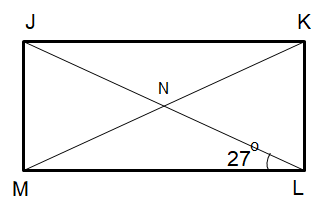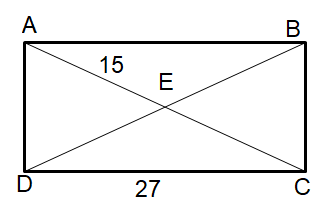PROBLEMS ON PROPERTIES OF RECTANGLE
Find the values of unknown.
Problem 1 :

Solution :
Length of the rectangle = 4 cm
Width of the rectangle = 3 cm
Property using :
Diagonals will bisect each other.
 |
AC2 = AB2 + BC2 AC2 = 42 + 32 AC2 = 16 + 9 AC = √25 AC = 5 |
Half of the diagonal = x ==> 5/2
x = 2.5 cm
Problem 2 :
Find the values of x and y.

Solution :
Since AB and DC are parallel, DB is transversal.
∠EDC = ∠EBA = 40
Since EB and EA are equal, they will have the equal angle measure.
∠EAB = 40 = x
In triangle EAB,
∠EAB + ∠EBA + ∠AEB = 180
x + x + y = 180
2x + y = 180
2(40) + y = 180
80 + y = 180
Subtracting 80 on both sides.
y = 180 - 80
y = 100
Problem 3 :
Find the value of x.

Solution :
In a rectangle opposite sides are equal and parallel.
The diagonal is a transversal, so x = 65.
Problem 4 :
In a given figure, ABCD is a rectangle and its diagonals meet at O. Find x, if OA = 2x + 4 and OD = 3x + 1. Also find BD.

Solution :
OA = OC = 2x + 4
OD = OB = 3x + 1
Property using :
Diagonals are equal and they will bisect each other.
OC = OD
2x + 4 = 3x + 1
2x - 3x = 1 - 4
-x = -3
x = 3
BO = 3(3) + 1 ==> 10
BD = 2BO ==> 2(10) ==> 20
Problem 5 :
The measure of the diagonal of a rectangle is 5 cm. If one of its sides is 3 cm, then find its perimeter.
Solution :
Diagonal of the rectangle = 5 cm.
One of the side = 3 cm.
Since the diagonal will divide the rectangle into two equal right triangles, we can use Pythagorean theorem.
Let x be the missing side of the rectangle.
Diagonal = Hypotenuse
52 = 32 + x2
25 = 9 + x2
Subtracting 9
25 - 9 = x2
x = √16
x = 4
So, the missing side of the rectangle is 4 cm.
Perimeter = 3 + 4 + 5 ==> 12 cm
Problem 6 :
ABCD is a rectangle and diagonals intersect at O. If ∠AOB = 118. Find
(i) ∠ABO (ii) ∠ADO (iii) ∠OCB

Solution :
(i) ∠OAB = ∠ABO
In triangle OAB,
∠OAB + ∠ABO + ∠AOB = 180
2∠OBA + 118 = 180
2∠OBA = 180 - 118
2∠OBA = 62
Dividing by 2, we get
∠OBA = 62/2
∠OBA = 31
(ii) In triangle ADB,
∠ADB + ∠DAB + ∠ABD = 180
∠ADB + 90 + 31 = 180
∠ADB + 121 = 180
∠ADB = 180 - 121
∠ADB = 59
(iii) ∠DAB = 90
∠DAB = ∠DAO + ∠OAB
90 = ∠DAO + 31
∠DAO = 90 - 31
∠DAO = 59
∠OCB = 59 (Alternate angles)
Problem 7 :
What is the area and length of the diagonal of a rectangle with adjacent side lengths of 24 cm and 7 cm?
Solution :
Adjacent sides of the rectangle is length and width.
length = 24 cm, width = 7 cm
Area of the rectangle = length x width
= 24 x 7
= 168 cm2
Using Pythagorean theorem :
242 + 72 = Diagonal2
576 + 49 = Diagonal2
Diagonal2 = 625
Diagonal = √625
Diagonal = 25
Problem 8 :
The diagonal of a rectangle has a length of 100 cm, and its length is twice its width. Find the area of this rectangle.
Solution :
Diagonal = 100 cm
Let x be the width of the rectangle. Length = 2x
x2 + (2x)2 = 1002
x2 + 4x2 = 10000
5x2 = 10000
x2 = 10000/5
x2 = 2000
x = √5 . 5 . 5 . 4 . 4)
x = (5. 4)√5
x = 20√5
Area of rectangle = 2x(x)
= 2x2
= 2(2000)
= 4000 cm2
Problem 9 :
Find
(i) SQ (ii) PR (iii) QR (iv) SR

Solution :
PQ = 24, PS = 10
Using Pythagorean theorem :
SQ2 = SP2 + PQ2
SQ2 = 102 + 242
SQ2 = 100 + 576
SQ2 = 676
SQ = 26
RP = 26 (since the diagonals are equal).
OQ = 10
SR = 24
Problem 10 :
Find
(i) ∠MJK (ii) ∠MJL (iii) ∠KML (iv) ∠MNL

Solution :
(i) ∠MJK = 90
(ii) ∠MJL :
In triangle JML
∠MJL + ∠MLJ + ∠JML = 180
∠MJL + 27 + 90 = 180
∠MJL + 117 = 180
∠MJL = 180 - 117
∠MJL = 63
(iii) ∠KML :
MN = ML
So, ∠KML = 27
(iv) ∠MNL
∠NML + ∠NLM + ∠MNL = 180
27 + 27 + ∠MNL = 180
54 + ∠MNL = 180
∠MNL = 180 - 54
∠MNL = 126
Problem 11 :
Find
(i) AD (ii) BD (iii) BC (iv) BE

Solution :
AC = 2AE
AC = 2(15) ==> 30
Using Pythagorean theorem :
AD2 + DC2 = AC2
AD2 + 272 = 302
AD2 + 729 = 900
AD2 = 900 -729
AD2 = 171
AD = √171
(i) AD = √171 (ii) BD = 30
(iii) BC = √171 (iv) BE = 15
Recent Articles
-
Finding Range of Values Inequality Problems
May 21, 24 08:51 PM
Finding Range of Values Inequality Problems -
Solving Two Step Inequality Word Problems
May 21, 24 08:51 AM
Solving Two Step Inequality Word Problems -
Exponential Function Context and Data Modeling
May 20, 24 10:45 PM
Exponential Function Context and Data Modeling